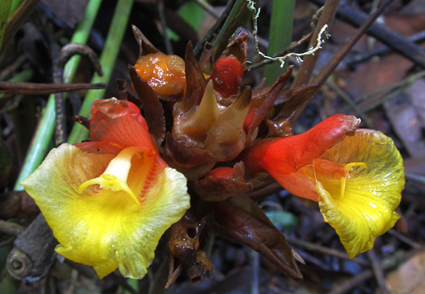Abstract
Conamomum vietnamense, a new species of Zingiberaceae, is described and illustrated from Tay Nguyen (Central Highlands), Vietnam. It is most similar to C. odorum and C. rubidum, but differs in having well-developed stilt roots, elliptic leaf blades, narrowly ovate bracts, abaxially pubescent bracteoles, longer calyx with 2 truncate lobes, broadly obovate to orbicular glabrous labellum, longer filament and glabrous style. Data on distribution, habitat, vernacular name, conservation status and a colour plate of the new species, along with a key to distinguish the species of Conamomum in Cambodia and Vietnam are given.
References
<p>Bachman, S., Moat, J., Hill, A.W., de Torre, J. & Scott, B. (2011) Supporting Red List threat assessments with GeoCAT: geospatial conservation assessment tool. <em>ZooKeys</em> 150: 117–126. https://doi.org/10.3897/zookeys.150.2109</p>
<p>Burtt, B.L. & Smith, R.M. (1972) Key species in the taxonomic history of Zingiberaceae. <em>Notes from the Royal Botanic Garden, Edinburgh</em> 31: 177–227.</p>
<p>de Boer, H., Newman, M., Poulsen, A.D., Droop, A.J., Fér, T., Lê, T.T.H., Hlavatá, K. Lamxay, V., Richardson, J.E., Steffen, K. & Leong-Škorničková, J. (2018) Convergent morphology in Alpinieae (Zingiberaceae): Recircumscribing <em>Amomum</em> as a monophyletic genus. <em>Taxon</em> 67 (1)<em>: </em>6–36. https://doi.org/10.12705/671.2</p>
<p>Gagnepain, F. (1906) Zingibéracées nouvelles de l’herbier du muséum. 15e note.<em> Bulletin de la Société botanique de France</em> 53: 132–150.<br>Gagnepain, F. (1908) <em>Amomum</em>. <em>In</em>: Lecomte, P.H., <em>Fl. Indo-chine</em> 6 (1), xxx, pp. 102–117.</p>
<p>Holttum, R.E. (1950) The Zingiberaceae of the Malay Peninsula. <em>Gardens’ Bulletin Singapore</em> 13: 224–236</p>
<p>IUCN Standards and Petitions Committee (2019) Guidelines for Using the IUCN Red List Categories and Criteria. Version 14. Prepared by the Standards and Petitions Committee. Available from: https://www.iucnredlist.org/resources/redlistguidelines.pdf (accessed 7 April 2020)</p>
<p>Lamxay, V. & Newman, M.F. (2012) A revision of <em>Amomum </em>(Zingiberaceae) in Cambodia, Laos and Vietnam. <em>Edinburgh Journal of Botany </em>69: 99–206. https://doi.org/10.1017/S0960428611000436</p>
<p>Luu, H.T., Tran, H.D., Nguyen, Q.D., Nguyen, T.Q.T. & Tran, G. (2019) <em>Conamomum odorum</em>, a new species of Zingiberaceae from Central Vietnam. <em>Academia Journal of Biology</em> 41 (3): 55–59. https://doi.org/10.15625/2615-0923/v41n3.13671</p>
<p>Phạm, H.H. (2000) <em>Amomum</em>.<em> In: Cay Co Vietnam: An illustrated flora of Vietnam</em> 3. Ho Chi Minh City, Nha Xuat Ban Tre. pp. 434–437.</p>
<p>Ridley, H.N. (1899) The Scitamineae of the Malay Peninsula. <em>Journal of the Straits Branch of the Royal Asiatic Society </em>32: 85–184.</p>
<p>Ridley, H.N. (1909) The Scitamineae of the Philippine islands. <em>Philippine Journal of Science. Section C, Botany</em> 4: 155–199.</p>
<p>Schumann, K.M. (1904) Zingiberaceae. <em>In: </em>Engler, A. (Ed.) <em>Das Pflanzenreich</em>, IV, 46 (Heft 20). Leipzig. pp. 1–458.</p>
<p>Sakai, S. & Nagamasu, H. (1998) Systematic Studies of Bornean Zingiberaceae I. <em>Amomum </em>in Lambir Hills, Sarawak. <em>Edinburgh Journal of Botany</em> 55 (1): 45–64.</p>
<p>Shorthouse, D.P. (2010) SimpleMappr, an online tool to produce publication-quality point maps. Available from: http://www.simplemappr.net (accessed 11 August 2020)</p>
<p>Smith, R.M. (1985) A review of Bornean Zingiberaceae: 1. (Alpineae p.p.). <em>Notes from the Royal Botanic Garden, Edinburgh </em>42: 261–314.Smith, R.M. (1986) A review of Bornean Zingiberaceae: 2. (Alpineae, concluded). <em>Notes from the Royal Botanic Garden, Edinburgh </em>43: 439–46<strong><em>. </em></strong>https://doi.org/10.1017/S0960428600004352</p>
<p>Thiers, B. (2018) [continuously updated] Index Herbariorum: A global directory of public herbaria and associated staff. New York Botanical Garden’s Virtual Herbarium. Available from: http://sweetgum.nybg.org/science/ih/ (accessed 20 April 2020)</p>
<p>Burtt, B.L. & Smith, R.M. (1972) Key species in the taxonomic history of Zingiberaceae. <em>Notes from the Royal Botanic Garden, Edinburgh</em> 31: 177–227.</p>
<p>de Boer, H., Newman, M., Poulsen, A.D., Droop, A.J., Fér, T., Lê, T.T.H., Hlavatá, K. Lamxay, V., Richardson, J.E., Steffen, K. & Leong-Škorničková, J. (2018) Convergent morphology in Alpinieae (Zingiberaceae): Recircumscribing <em>Amomum</em> as a monophyletic genus. <em>Taxon</em> 67 (1)<em>: </em>6–36. https://doi.org/10.12705/671.2</p>
<p>Gagnepain, F. (1906) Zingibéracées nouvelles de l’herbier du muséum. 15e note.<em> Bulletin de la Société botanique de France</em> 53: 132–150.<br>Gagnepain, F. (1908) <em>Amomum</em>. <em>In</em>: Lecomte, P.H., <em>Fl. Indo-chine</em> 6 (1), xxx, pp. 102–117.</p>
<p>Holttum, R.E. (1950) The Zingiberaceae of the Malay Peninsula. <em>Gardens’ Bulletin Singapore</em> 13: 224–236</p>
<p>IUCN Standards and Petitions Committee (2019) Guidelines for Using the IUCN Red List Categories and Criteria. Version 14. Prepared by the Standards and Petitions Committee. Available from: https://www.iucnredlist.org/resources/redlistguidelines.pdf (accessed 7 April 2020)</p>
<p>Lamxay, V. & Newman, M.F. (2012) A revision of <em>Amomum </em>(Zingiberaceae) in Cambodia, Laos and Vietnam. <em>Edinburgh Journal of Botany </em>69: 99–206. https://doi.org/10.1017/S0960428611000436</p>
<p>Luu, H.T., Tran, H.D., Nguyen, Q.D., Nguyen, T.Q.T. & Tran, G. (2019) <em>Conamomum odorum</em>, a new species of Zingiberaceae from Central Vietnam. <em>Academia Journal of Biology</em> 41 (3): 55–59. https://doi.org/10.15625/2615-0923/v41n3.13671</p>
<p>Phạm, H.H. (2000) <em>Amomum</em>.<em> In: Cay Co Vietnam: An illustrated flora of Vietnam</em> 3. Ho Chi Minh City, Nha Xuat Ban Tre. pp. 434–437.</p>
<p>Ridley, H.N. (1899) The Scitamineae of the Malay Peninsula. <em>Journal of the Straits Branch of the Royal Asiatic Society </em>32: 85–184.</p>
<p>Ridley, H.N. (1909) The Scitamineae of the Philippine islands. <em>Philippine Journal of Science. Section C, Botany</em> 4: 155–199.</p>
<p>Schumann, K.M. (1904) Zingiberaceae. <em>In: </em>Engler, A. (Ed.) <em>Das Pflanzenreich</em>, IV, 46 (Heft 20). Leipzig. pp. 1–458.</p>
<p>Sakai, S. & Nagamasu, H. (1998) Systematic Studies of Bornean Zingiberaceae I. <em>Amomum </em>in Lambir Hills, Sarawak. <em>Edinburgh Journal of Botany</em> 55 (1): 45–64.</p>
<p>Shorthouse, D.P. (2010) SimpleMappr, an online tool to produce publication-quality point maps. Available from: http://www.simplemappr.net (accessed 11 August 2020)</p>
<p>Smith, R.M. (1985) A review of Bornean Zingiberaceae: 1. (Alpineae p.p.). <em>Notes from the Royal Botanic Garden, Edinburgh </em>42: 261–314.Smith, R.M. (1986) A review of Bornean Zingiberaceae: 2. (Alpineae, concluded). <em>Notes from the Royal Botanic Garden, Edinburgh </em>43: 439–46<strong><em>. </em></strong>https://doi.org/10.1017/S0960428600004352</p>
<p>Thiers, B. (2018) [continuously updated] Index Herbariorum: A global directory of public herbaria and associated staff. New York Botanical Garden’s Virtual Herbarium. Available from: http://sweetgum.nybg.org/science/ih/ (accessed 20 April 2020)</p>


